Workout Plans for 12 Common Injuries
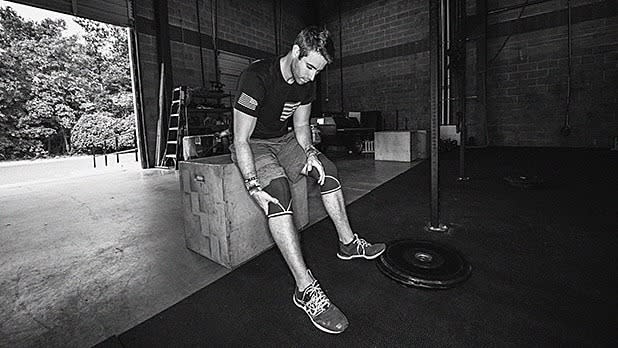
(Photo Courtesy of Corey Jenkins / Getty Images)
Injuries are opportunities in disguise. Whether from overuse or an accident, an inability to use part of your body can help you assess your overall physiology and get you out of a fitness rut. “Most people avoid exercising their weakest parts in the gym,” says David Reavy, owner of React Physical Therapy in Chicago. “This is a chance to focus on those areas and strengthen them.” With the help of Reavy and Chris Phillips, owner of Compete Sports Performance and Rehab in Lake Forest, California, we offer guidance for staying in shape — or getting even more fit — while healing from the most common injuries.
Related: The 5 Most Painful Everyday Injuries
Injury: Plantar Fasciitis
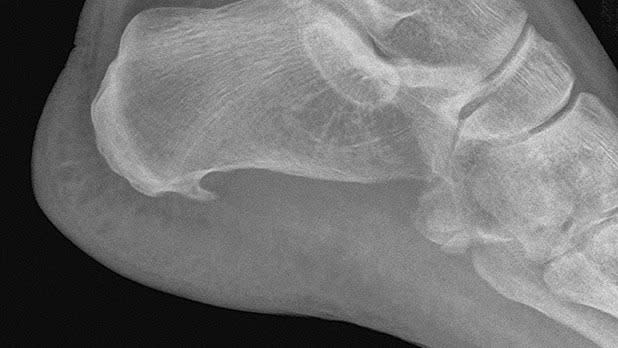
(Photo Courtesy of Getty Images)
The Workouts: Bench Presses, Deadlifts, Push Presses, Kettlebell Swings
This overuse injury hits your arch and heel and can result in a stabbing pain in your foot — something that makes it tough to know what activities won’t injure it further. “You have to switch your training focus from plyometrics, like lunges, sprints, and jumps, to more sedentary kinds of strength training,” says Rob Van Valkenburgh, head strength and speed coach at the Denver location of D1 Sports Training. “Don’t do anything where your heel becomes elevated off the ground, so work your lower body with squats, benches, deadlifts, and do dumbbell work for your upper body instead of moves like push presses.” As for cardio, it can be hard to do activities like running with plantar fasciitis. “Riding a bike is fine as long as you don’t drive through your arch,” says Van Valkenburgh. “You can also get your heart rate up by doing something high intensity, like kettlebell swings paired with push-ups.”
Related: The Real Reason You Have Plantar Fasciitis (and How to Fix It)
Injury: Knee and Ankle Sprains
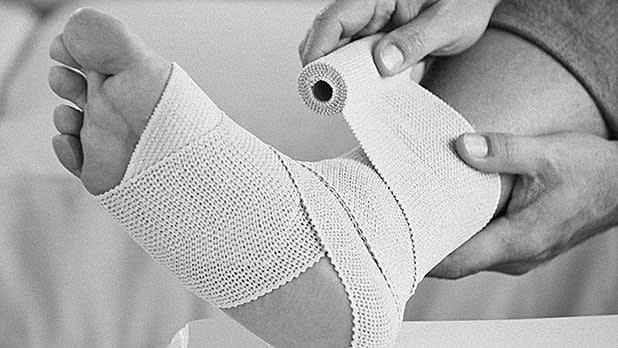
(Photo Courtesy of Getty Images)
The Workouts: Elliptical Machine, Arm Bikes, Walls Sits
“With this injury, you want to do motions that keep the motion going forward, not side-to-side,” says Phillips. “So basketball or trail running aren’t great options.” His advice is to head to an elliptical, since there’s no pounding or impact, and if that hurts, go to a bike. “If even the bike hurts, head to something like an aerodyne bike or versaclimber, which are cardio machines that work your arms,” he says. Since your arms are weaker than your legs and will get tired more quickly, don’t try to just do 30 minutes straight on those machines. Instead, do intervals where you go for three minutes, then hit the ground for some core work or ankle rehab work, then go back to the machine. “For leg strength, a lot depends on the severity of the injury,” he says. “Try something isometric, like a wall sit where you hold it for a minute. It makes your quads feel like they’re on fire but has absolutely no movement to make your knee or ankle throb.”
Related: How to Heal a Sprained Ankle
Injury: Shin Splints
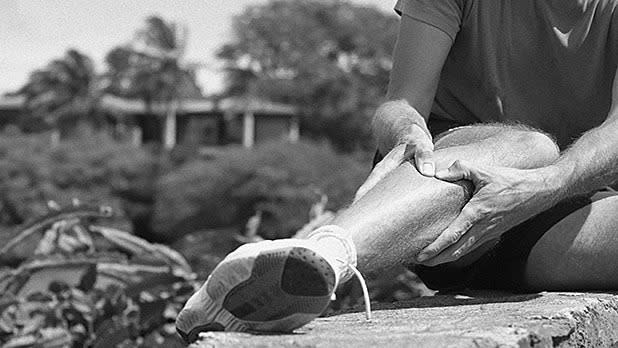
(Photo Courtesy of Getty Images)
The Workouts: Weight Training, Intervals
Shin splints can flare up when you overuse parts of your lower body by running long distances or doing demanding workouts like Crossfit. “The good news with shin splints is that they’re easy to work around,” says Van Valkenburgh. “Shins aren’t often activated when doing weight training, so you’re in the clear there.” When it comes to cardio, you need to avoid doing activities that impact the front of your shin. “Running is out of the question since it involves constant pounding and requires you to flex your toe up,” he says. “But swimming and biking are both good.” Another way to do cardio when you have shin splints is to do intervals. “Shin splints flare up more the longer you do an exercise,” say Van Valkenburgh. “So do of doing a steady hour of low-intensity cardio, switch to interval training where you bike all out for 45 seconds, recover for 45 seconds, and repeat for 15 minutes.”
Related: The Real Reason You Have Shin Splints
Injury: Broken Arm
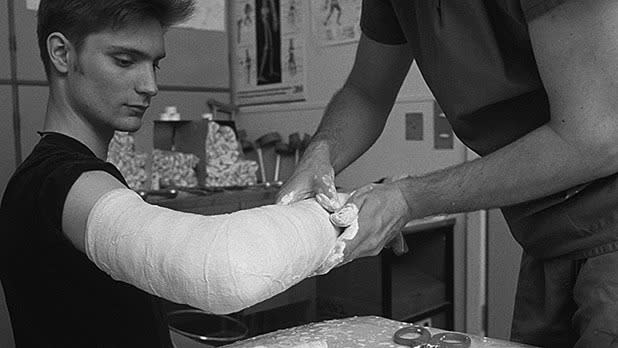
(Photo Courtesy of Getty Images)
The Workouts: Safety Squats, YTW Holds
There are a lot of ways to break an arm, and what you can do at the gym afterwards often depends on the location of the break. “The most common break I see is closer to your hand, and with that kind of break there are lots of options to staying strong,” says Van Valkenburgh. “They make specialty bars called safety squat bars, which let you do weighted squats without putting your hand, wrist, or elbow in a compromised position.” Another good way to keep your chest and back strong are isometric holds like the YTW. Lie on your stomach on the floor, lift your chest up, and make a Y with your arms (they’re straight out in front of you), then a T (arms go out to the side), then a W (bend elbows). Also check if your gym has a cable machine with a cuff made to go around ankles. Van Valkenburgh recommends wrapping the cuff around your bicep so you can do moves like the chest fly without having to hold anything in your hand.
Related: How to Do a Perfect Squat
Injury: Pulled Hamstring
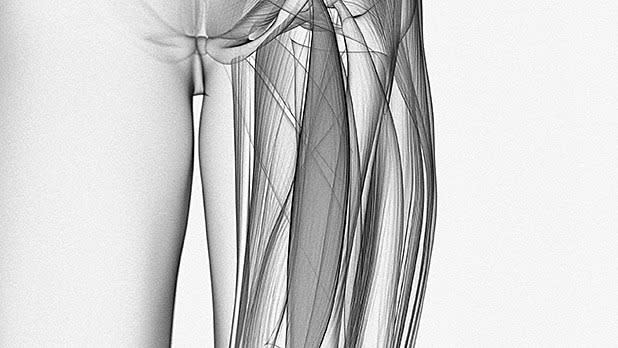
(Photo Courtesy of Getty Images)
The Workouts: Swimming, Leg Extensions
“Off-limit movements include leg curls, dead lifts, that sort of thing,” says Van Valkenburgh. “Really most leg-based moves need to be avoided — even biking isn’t good because it requires a pulling movement with your hamstring.” That said, one good cardio choice is swimming—breast stroke, specifically. “It mostly uses your upper body and has no leg pulling motion involved,” says Van Valkenburgh. If the pull is minor, you can do single leg squats with your healthy leg (but don’t do that if your recovery will take a long time — you don’t want to end up with a huge strength imbalance between your two legs). Another option is to use the leg extension machine to keep your quads strong. “You can maintain glute strength by doing lateral band walks and isometric bridges,” says Van Valkenburgh. “Pain is your indicator. If something starts hurting, stop the movement.”
Injury: ACL/MCL Tear

(Photo Courtesy of Getty Images)
The Workouts: Planks, the Clam, Indoor Cycling
“A lot of times I’ll see people a year after this knee injury and their injured leg is so much smaller than their other one,” says Reavy. “You don’t want to bend your knee a lot or put weight or stress on it, so focus on your hips, glutes, and core,” he says. He suggests doing basic exercises where you don’t have to put weight on your injured leg or where you can keep your leg straight. For example, planks to work your core and moves like the Clam to exercise your hips. Lie on your side with knees bent, open knees like a clam shell, hold for five seconds, then slowly close them. Make sure you don’t roll backwards as you do this move and keep your heels together. Two weeks after most of these injuries, you should be able to do an indoor bike for cardio — just make sure to keep the resistance low.
Injury: IT Band Syndrome
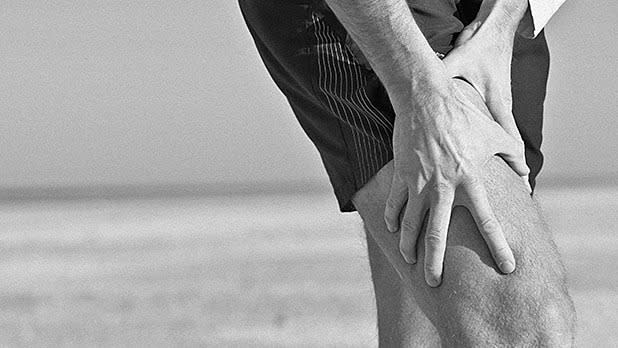
(Photo Courtesy of Getty Images)
The Workout: Inner Thigh Squats, Stair Machines
IT band syndrome, the scourge of runners and office workers, describes a situation where you’ve developed severe pain along the big band that runs down your outer thigh. “One thing that can lead to this injury is if you aren’t stabilizing yourself properly due to weak hips and core,” says Reavy. “No exercises are off limits here actually, so work on strengthening those areas.” A great move to do is inner thigh squats. Stand with feet shoulder-width apart, toes pointed out at 45 degrees. Squat down and push your hips back as far as you can while moving knees out. Go as low as possible while keeping weight in your heels, then push up through heels to stand. Perform the same exercise again, but this time keeping weight in the balls of your feet as you go down and up.
“Instead of running for cardio, try the revolving stair machine or sprinting on a treadmill set at an incline,” says Reavy. “Those activities will work your posterior chain properly and help you avoid landing too hard, like you might do on a run.”
Injury: Ruptured Achilles
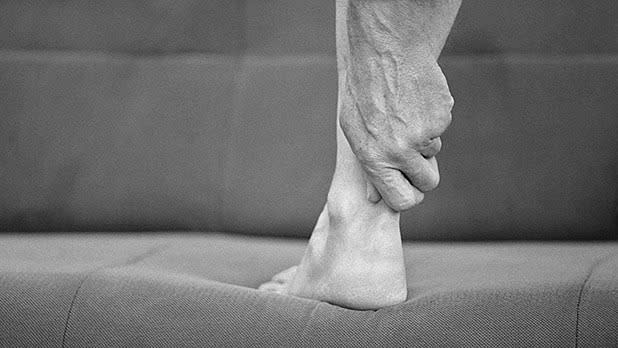
(Photo Courtesy of Getty Images)
The Workout:Lat Pull-Downs, Arm Biking
A tight arch and tight calf muscle can create so much stress on your Achilles tendon that it gets injured. “If you have to have surgery, you’re going to end up in a walking boot and won’t want to do any weight-bearing exercises because you’ll be so off-balance,” says Reavy. “Instead, focus on core strengthening, lat strengthening, and non-weight-bearing exercises for hips.” Head to the gym and do lat pull-downs on a machine while kneeling (this gets glutes and your core engaged better than if you do it sitting). Reavy suggests heading to an arm bike to keep your cardio fitness levels up — go forwards and backwards on the arm bike to work your front and back muscles.
Related: The 10 Moves You Need to Get a Rock-Solid Core
Injury: Golfers Elbow/Tennis Elbow

(Photo Courtesy of Getty Images)
The Workout: Modified Rows, Push-Ups
Whether you’re a golfer who has injured the inside of your elbow or a tennis player who has hurt the outside of the elbow, these injuries can make bicep curls and other moves that involve bending the arm painful. “You can still strengthen your upper body by doing seated rows or push-ups in a way that takes stress off your elbows and instead puts it on your shoulder blades,” says Reavy. Here’s how to do that: Place two dumbbells on the floor, about three inches outside of your shoulders, turned out to 45 degrees. Place hands on dumbbells and perform push-ups. As you lower yourself down, “punch” forward with your shoulders and stop when your elbows reach a 90-degree angle. You can also try getting into a downward dog position and doing push-ups from there.
Injury: Calf Tears

(Photo Courtesy of Getty Images)
The Workout: Rowing, Squats, Lunges, Seated Leg Extensions
If you have a major calf tear, you’ll get put in a boot. But minor injuries usually mean you can still walk. “Pushing off will bother you with this injury, but you can do exercises that keep the weight in your heels,” says Reavy. “Do squats, lunges (keep the injured leg in front), seated leg extensions, and moves like that.” For cardio, head to the rowing machine and make sure you’re pushing through your heels when rowing.
Injury: Lower Back Pain

(Photo Courtesy of Getty Images)
The Workout: Leg Presses, Cycling
“It’s really good to get your body moving when you have lower back pain and there aren’t a lot of bad exercises you should steer clear from,” says Phillips. “Get started by doing some lower-impact cardio, say by riding a bike or doing an elliptical.” His one concern would be to avoid any overhead weight moves. “Don’t do standing overhead presses or back squats with a heavy weight on your shoulders because you’ll compress your spine,” he says. “I’m not a big machine guy, but this is where those machines can come in handy because you can do a leg press where you’re working your legs while also supporting your back.”
Injury: Rotator Cuff Strains
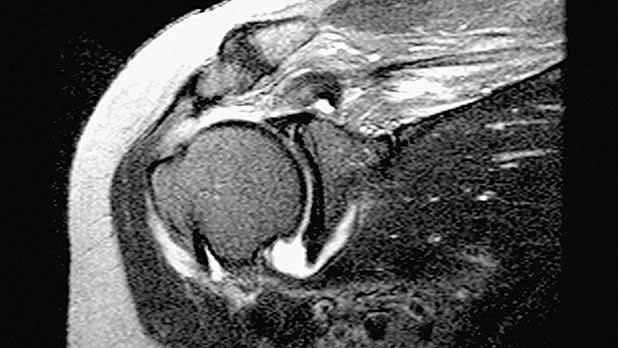
(Photo Courtesy of Getty Images)
The Workout: Rows, Front Squats
“Like many injuries, what you can do to work out comes down to the severity of the injury,” says Phillips. “So if it’s minor, you can still run or do the elliptical, but if it’s more of a strain, the pushing and pulling with your arms might be too much for your shoulder.” One option is to do the elliptical while holding on to the stationary handles in front. He also suggests doing rows with lower weights and higher reps. Lie on your stomach on a bench and raise arms straight out to sides. Start with no weights then go up to five pounds (you’re working smaller muscles on the back of your shoulder, so that’s enough weight). “I’d also stay away from heavy squats where your arms are holding the bar behind your head,” says Reavy. “Go for a front squat or leg press until your shoulder has healed.”
By Alice Oglethorpe
More from Men’s Journal:
The Only 10 Moves You Need to Stay Injury-Free
